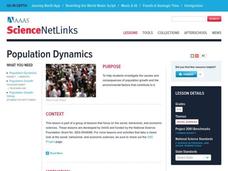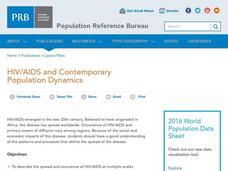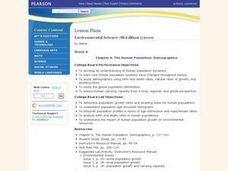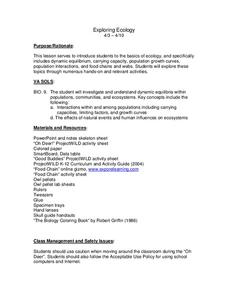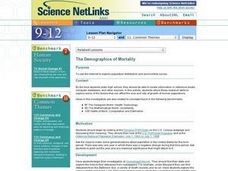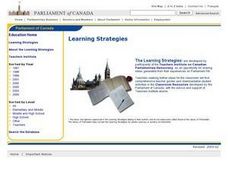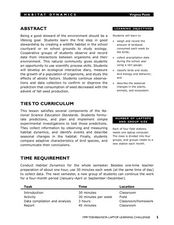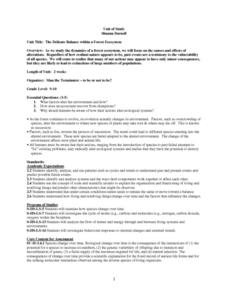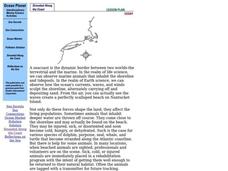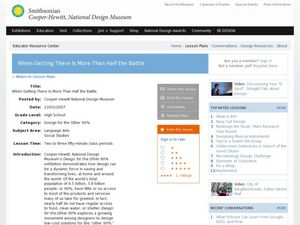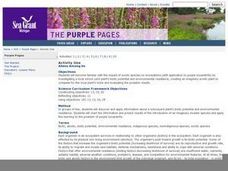Curated OER
Population Dynamics
Students investigate the causes and consequences of population growth and the envrionmental factors that contribute to it. They discuss what they think the world's population will be in 2050.
Curated OER
HIV/AIDS And Contemporary Population Dynamics
Students describe the spread and occurence of HIV/AIDS at multiple scales. They explain global and regional variations in the occurence of HIV/AIDS and explain the spread of HIV/AIDS in the United States.
Curated OER
Mapping Population Changes In The United States
Students create a choropleth map to illustrate the population growth rate of the United States. They explore how to construct a choropleth map, and discuss the impact of population changes for the future.
Curated OER
HIV/AIDS and Contemporary Population Dynamics
Pupils describe the spread and occurrence of HIV/AIDS at multiple scales.
They explain global and regional variations in the occurrence of HIV/AIDS
and the spread of HIV/AIDS in the United States
Curated OER
Analyzing the Job Market for Babysitting in Your Neighborhood
Learners conduct research on a neighborhood in Canada. In this data analysis instructional activity, students use data from the 2006 Canadian census to draw conclusions about a population group.
Curated OER
Chapter 6: The Human Population: Demographics
Students read the indicated text and complete several suggested labs and activities. They answer critical thinking questions. This instructional activity is very hard to do without the indicated text.
Curated OER
Exploring Ecology
Pupils explore the basics of ecology through numerous hands-on and relevant activities. They participate in an online food chain demonstration, which explores food web dynamics. They dissect owl pellets, examine the prey's bones, and...
Curated OER
The Demographics of Mortality
Students view the Dynamic POPClocks on the U.S. Census webpage and discuss their meaning. They explore age-related death rates of the human population and collect information about the deaths of humans and organize them into a life table.
Curated OER
World's Most Dynamic Force
Students explore the Earth's forces. They review an assessment task and its accompanying rubric. They classify ten items as long-term or short-term interactions of the Earth's components and rank the destructive impact of the forces. ...
Curated OER
The Dynamics of the Leadership Process
Students explain the dynamics surrounding the selection of a leader for a country. They explain the involvement of individual citizens in the selection process.
Curated OER
Myths and Reality of Old Age
Students use a glossary of terms to learn about mature adults. They examine common stereotypes in aging. They create awareness of language that contributes to age discrimination and stereotyping. They discuss the social, psychological,...
Curated OER
Habitat Dynamics
Young scholars develop an interactive diary to record bird seed consumption. In this habitat lesson, students predict and record the amount of birdseed eaten each week by birds.
Curated OER
The Delicate Balance within a Forest Ecosystem
Students examine the causes and effects of alterations in a forest ecosystem and evaluate how human actions may only seem to have minor consequences, but can lead to extinctions of large numbers of populations. Students produce an...
Curated OER
Stranded Along The Coast
Students reflect and investigate how a seacoast is the dynamic border between two worlds-the terrestrial and the marine. In the realm of life science, we can observe marine animals that inhabit the shoreline and tidepools. In the realm...
Curated OER
Cypress/Tupelo Swamps
Students study the geologic history of terrain, soils, and drainage patterns. They recognize ecological processes that determine the dynamic nature of habitats. They investigate the influence of human activity on the landscape.
Curated OER
The Business of Design
Students visit the Design for the Other 90% exhibition. In this design lesson, student learn how to design for the population of the world that is poor or impoverished. In addition, students read New York Times articles and watch videos...
Curated OER
When Getting There is More Than Half the Battle
High schoolers investigate the 'Design for the Other 90%' exhibition about low-cost solutions to give the "other 90% of the world's population" access to services and amenities many of us take for granted. In this technology design...
Virginia Department of Education
Succession
The final instructional activity in a two-part series prompts scholars to create newspaper articles and succession events. Applying their knowledge of the ecosystem and the past examples of succession, they predict what will happen...
Curated OER
Acid Rain
Create a simulation of acid rain in your classroom with lemon juice and bean plants to help kids study the effects of pollution on plants. In addition, learners will listen to a story and write responses based on guiding questions.
Curated OER
Fish Parasite Survey
Students survey and dissect as many fish as possible. They count nematodes, cestodes and crustaceans on the fish, fill out autopsy reports, and transfer data to a chalkboard data table. Students graph the results of the entire class...
Curated OER
Aliens Among Us
Pupils identify plants growing in the school yard and choose one for further investigation. They investigate the plant's biotic potential and environmental resistance. They predict what would happen should they introduce an exotic plant...
Curated OER
Education, Design & Empowerment: Part One
Middle schoolers consider the connection between poverty and education. In this language arts and social studies lesson plan, students research primary and secondary sources in order to explore the relationship between education and...
Curated OER
You are the Curator: Building a Museum of the 1920s and 1930s
Students examine primary and secondary sources regarding 1920's and 1930's America. In this Webquest lesson, students explore sources regarding the American decades in order to create their own museum exhibits.
Curated OER
The Monarch Butterfly Watch
Students explore monarch migration through the Journey North web site. In this butterfly lesson plan, students use the internet to identify a butterfly's migration pattern. Students write in electronic journals.
Other popular searches
- Animal Population Dynamics
- Human Population Dynamics
- Ecology Population Dynamics
- Population Dynamics Yeast
- Climate Population Dynamics
- Passport Population Dynamics
